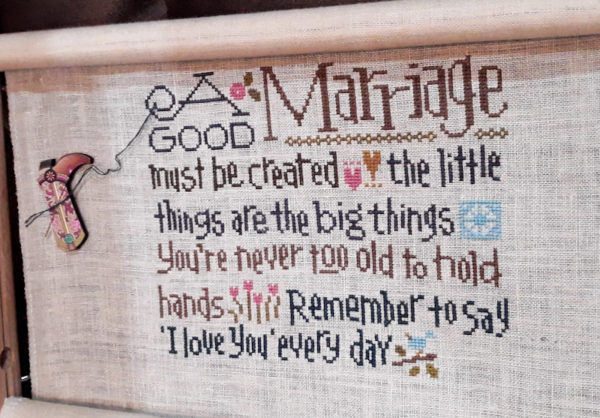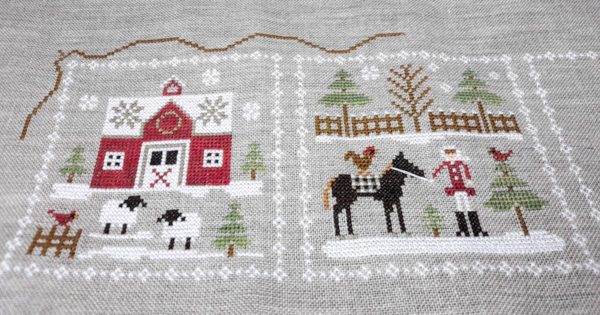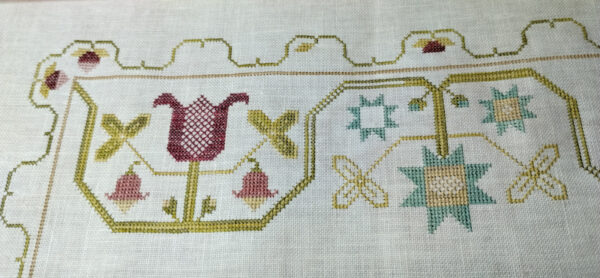The lessons I’ve learned since I began cross stitching are lessons I should have learned through the years with quilting, knitting and anything else I’ve tried. I probably did learn them but had forgotten them.

Above is the first piece I stitched. I started it in December, 2020.
Below is a Farmhouse Christmas, started in February, 2021.

I knew that my stitching didn’t look as good as what I was seeing on Instagram. In the pictures, it looks ok. Sometimes I crossed the “x” one way and sometimes I crossed it the other way.There are lines that are not straight. Sometimes stitches cover three threads; sometimes two. I was stitching on 28 and 30 count . . how could I not get that right?
When I would post pictures, you very kind readers would tell me it looked great. Even when I said my stitches weren’t great, I was assured it looked fine and, yes, it does look fine, but I knew I could do better. On the wall, I love everything I’ve stitched.
But, when I look at what I’m stitching now, though not perfect, it does look so much better than my first few pieces, and even the pieces I did last year.

As far as I know, I’m always stitching over two threads. Now that I know to always put my needle through a hole where the vertical thread crosses a horizontal thread, it’s not easy to miss the correct hole.
Another thing I’ve learned is to stop and find a “pattern” or path. When I stitched the leaves on the left flower, I thought they were so confusing and I kept having to check the chart and count; count and re-check the chart. When I got to the leaves on the middle section, it clicked and I could stitch the entire leaf without looking back at the chart. That meant instead of about 15 minutes per leaf, it was about 5 minutes per leaf. Really!
One of the things I saw on a flosstube recently, and I’m sorry I can’t remember who said it but when stitching a repeat, especially a border, the stitcher said she would go through her working copy and make sure that every repeat was exactly the same and make a note of where it wasn’t the same. Example: Smith Sampler – the entire border is the same repeat EXCEPT the center on the top (and maybe the bottom), there’s an extra stitch in that center repeat. I’m sorry for her but thankful that Sheri from Colorado Cross Stitcher made the mistake of not noticing that and shared it in a flosstube. I would have made that same mistake had Sheri not mentioned it but now, and only just recently, I go through and check everything in the border before starting to stitch.

I always stitch the border first. In the border shown above, I stitched the outer green border first and made sure it matches up. I pick a spot in the border where, if it wasn’t going to match up perfectly, I could add or drop a stitch without it being noticeable, usually in a corner but not always. In the border above, it was one of those sections where the green border is against the red stitching . . that’s where I had planned to add an extra stitch or leave off a stitch if the border didn’t meet up but honest, I would probably find my error, rip back to that point and re-stitch it.
I hope I will continue to learn, and my stitches will continue to improve. I also hope that for myself and for any reading this that we will never be afraid to try something new, that we will always understand that our first projects may not be close to perfect, but things will improve with practice. This applies to making bread, smoking meat, sewing clothes, planting a garden, knitting . . most anything new we’re trying.
In my opinion, it’s much better to try something I want to try, and have a finished product that isn’t quite perfect, than to never try!

Shelley says
I can so relate to your post. I just learned from Vonnie to go down with the eye and up with the pointed end of the needle plus keep twists out. Thread lies flat. My stitches look better already! Never too old to learn. Love your posts
judy.blog@gmail.com says
I learned that from her too and I’m loving it. I was having a problem with the end of the needle splitting the thread (I only use one strand) so I started going up with the eye (which means the thread is hanging down and not getting caught on the eye) and down with the point. Either way, that’s an amazing trick.
Betty edwards says
Okay Judy I have my linen for my first attempt at using it. Thanks for your encouragement but how do you find how to begin. I know how to do it on Aida but Linen is a new animal. I can’t seem to start! Lolo HELP! I did stitch some in the excess so I am sorta comfortable with that!
judy.blog@gmail.com says
What part are you not sure about – where to start, where to come up, how to secure the thread? All of the above?